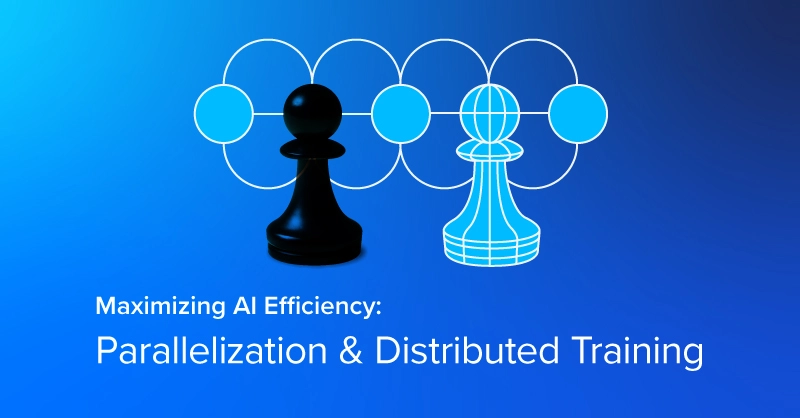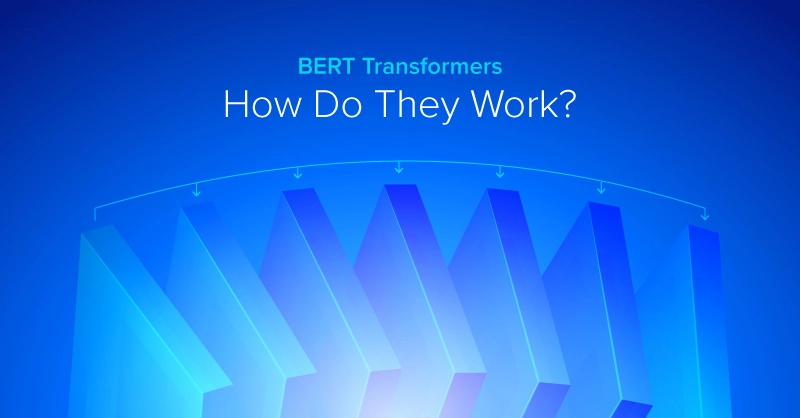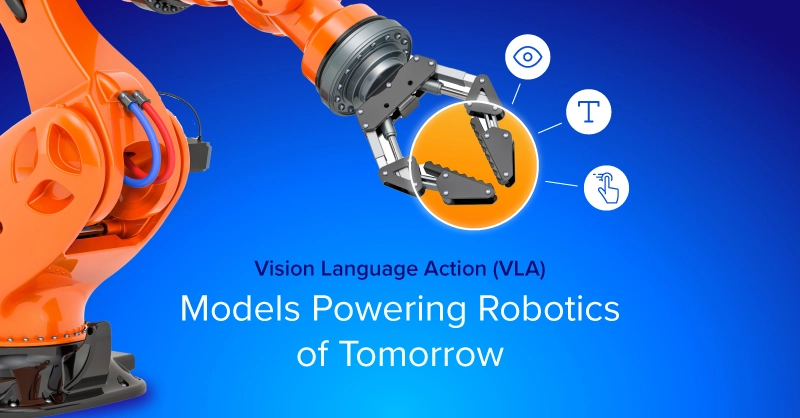
Introduction
As AI models grow larger and datasets expand, training these models becomes increasingly challenging. Training complex AI has necessitated multiple GPUs and Distributed training architecture addresses this challenge by leveraging multiple computational resources to train AI models efficiently. This approach allows developers to tackle massive datasets and complex models while reducing training time. Below, we’ll explore the components of distributed training architecture, the various types of parallelism, and how to select the right approach for your workload.
Read about maximizing AI efficiency by Selecting the Right Model and Tuning and Regulation.
Key Components of Distributed Training Architecture
Distributed training systems rely on several foundational components to ensure efficiency and scalability:
- Computing Resources: GPU Clusters with high-speed interconnects like NVIDIA's NVLink or InfiniBand are required for fast networking and connecting numerous servers and upwards of thousands of GPUs. GPUs dominate in training due to their high parallel compute capabilities, NVIDIA in particular. The NVIDIA Blackwell and NVIDIA Hopper have been deployed in countless data centers and power the world's most complex models such as ChatGPT or facilitate innovative research at top universities.
- Communication Mechanisms: Synchronization of model parameters across devices is achieved via technologies like NCCL (NVIDIA Collective Communications Library) or gRPC. Efficient communication strategies, such as ring all-reduce, minimize overhead.
- Parameter Management: Parameter servers or decentralized approaches (e.g., all-reduce) handle gradient aggregation and model updates. All systems in the deployment send updated weights to a common location to continue further training.
- Framework Support: Popular frameworks like TensorFlow, PyTorch, and MXNet offer native tools for distributed training. There are many other frameworks to consider, so make your choice as educated as possible.
Types of Parallelism in Distributed Training
Distributed training employs different parallelism strategies based on the model, dataset, and hardware requirements. Understanding when and how to use each type of parallelism is critical for designing efficient systems.
Data Parallelism
In data parallelism, the dataset is split into smaller chunks, and each worker trains a complete copy of the model on its data subset. Gradients are then synchronized across all workers. Data parallelism is suitable when the dataset is too large to process on a single server, but the model fits within the system's memory. High-speed interconnect between GPUs is used to reduce synchronization overhead. Data parallelism is the most widely used architecture.
Model Parallelism
In model parallelism, the model is divided across multiple devices, each handling a portion of the architecture (e.g., layers or submodules). Model parallelism is often used when the model is too large to fit on a single device's memory and is ideal for massive architectures such as GPT or other Transformer-based models. It is used in specialized cases, often in conjunction with data parallelism.
Pipeline Parallelism
In pipeline parallelism, the model is split into sequential stages, with each stage handled by a different GPU or set of GPUs. Mini-batches are processed in a staggered manner, similar to an assembly line.
The pipeline parallelism method is used when the model is large, but its structure allows splitting into sequential stages. It is beneficial when overlapping computation and communication reduces latency. Often, pipeline parallelism is combined with other parallelism strategies for deep architectures.
Hybrid Parallelism
Hybrid Parallelism combines data and model parallelism to optimize both dataset handling and model scaling, ideal when both the model and dataset are too large for simple data or model parallelism alone. Hybrid is common in cutting-edge complex AI models like GPT and PaLM.
Leveraging two parallelism models is essential for large-scale training systems found in LLMs.
Federated Learning
Federated Learning is a decentralized training approach where data remains on local devices, and only model updates are aggregated. It is ideal when data privacy or regulation prohibits centralizing datasets.
Furthermore, federated learning is often used in edge computing scenarios or for training models on personal devices, often only used in applications that have high data privacy.
Example Use Cases
- Training Vision Models: Data parallelism suffices for CNN-based models like ResNet when datasets are large but models fit on individual GPUs.
- Language Models: Hybrid parallelism is often required for Transformer models like GPT due to their size and complexity.
- Scientific Simulations: Model parallelism is effective for highly detailed simulations that require extensive compute and memory resources.
- Edge AI: Federated learning enables privacy-preserving training on distributed edge devices.
Conclusion
Distributed training architecture is the cornerstone of modern AI development, enabling the training of larger models and handling vast datasets efficiently. Selecting the right parallelism strategy and optimizing components like memory, communication, and fault tolerance are key to maximizing AI efficiency. Whether it’s training cutting-edge language models or scaling computer vision applications, understanding these architectural principles ensures successful outcomes in AI projects.

Maximizing AI Efficiency: Parallelization and Distributed Training
Introduction
As AI models grow larger and datasets expand, training these models becomes increasingly challenging. Training complex AI has necessitated multiple GPUs and Distributed training architecture addresses this challenge by leveraging multiple computational resources to train AI models efficiently. This approach allows developers to tackle massive datasets and complex models while reducing training time. Below, we’ll explore the components of distributed training architecture, the various types of parallelism, and how to select the right approach for your workload.
Read about maximizing AI efficiency by Selecting the Right Model and Tuning and Regulation.
Key Components of Distributed Training Architecture
Distributed training systems rely on several foundational components to ensure efficiency and scalability:
- Computing Resources: GPU Clusters with high-speed interconnects like NVIDIA's NVLink or InfiniBand are required for fast networking and connecting numerous servers and upwards of thousands of GPUs. GPUs dominate in training due to their high parallel compute capabilities, NVIDIA in particular. The NVIDIA Blackwell and NVIDIA Hopper have been deployed in countless data centers and power the world's most complex models such as ChatGPT or facilitate innovative research at top universities.
- Communication Mechanisms: Synchronization of model parameters across devices is achieved via technologies like NCCL (NVIDIA Collective Communications Library) or gRPC. Efficient communication strategies, such as ring all-reduce, minimize overhead.
- Parameter Management: Parameter servers or decentralized approaches (e.g., all-reduce) handle gradient aggregation and model updates. All systems in the deployment send updated weights to a common location to continue further training.
- Framework Support: Popular frameworks like TensorFlow, PyTorch, and MXNet offer native tools for distributed training. There are many other frameworks to consider, so make your choice as educated as possible.
Types of Parallelism in Distributed Training
Distributed training employs different parallelism strategies based on the model, dataset, and hardware requirements. Understanding when and how to use each type of parallelism is critical for designing efficient systems.
Data Parallelism
In data parallelism, the dataset is split into smaller chunks, and each worker trains a complete copy of the model on its data subset. Gradients are then synchronized across all workers. Data parallelism is suitable when the dataset is too large to process on a single server, but the model fits within the system's memory. High-speed interconnect between GPUs is used to reduce synchronization overhead. Data parallelism is the most widely used architecture.
Model Parallelism
In model parallelism, the model is divided across multiple devices, each handling a portion of the architecture (e.g., layers or submodules). Model parallelism is often used when the model is too large to fit on a single device's memory and is ideal for massive architectures such as GPT or other Transformer-based models. It is used in specialized cases, often in conjunction with data parallelism.
Pipeline Parallelism
In pipeline parallelism, the model is split into sequential stages, with each stage handled by a different GPU or set of GPUs. Mini-batches are processed in a staggered manner, similar to an assembly line.
The pipeline parallelism method is used when the model is large, but its structure allows splitting into sequential stages. It is beneficial when overlapping computation and communication reduces latency. Often, pipeline parallelism is combined with other parallelism strategies for deep architectures.
Hybrid Parallelism
Hybrid Parallelism combines data and model parallelism to optimize both dataset handling and model scaling, ideal when both the model and dataset are too large for simple data or model parallelism alone. Hybrid is common in cutting-edge complex AI models like GPT and PaLM.
Leveraging two parallelism models is essential for large-scale training systems found in LLMs.
Federated Learning
Federated Learning is a decentralized training approach where data remains on local devices, and only model updates are aggregated. It is ideal when data privacy or regulation prohibits centralizing datasets.
Furthermore, federated learning is often used in edge computing scenarios or for training models on personal devices, often only used in applications that have high data privacy.
Example Use Cases
- Training Vision Models: Data parallelism suffices for CNN-based models like ResNet when datasets are large but models fit on individual GPUs.
- Language Models: Hybrid parallelism is often required for Transformer models like GPT due to their size and complexity.
- Scientific Simulations: Model parallelism is effective for highly detailed simulations that require extensive compute and memory resources.
- Edge AI: Federated learning enables privacy-preserving training on distributed edge devices.
Conclusion
Distributed training architecture is the cornerstone of modern AI development, enabling the training of larger models and handling vast datasets efficiently. Selecting the right parallelism strategy and optimizing components like memory, communication, and fault tolerance are key to maximizing AI efficiency. Whether it’s training cutting-edge language models or scaling computer vision applications, understanding these architectural principles ensures successful outcomes in AI projects.




.jpg?format=webp)